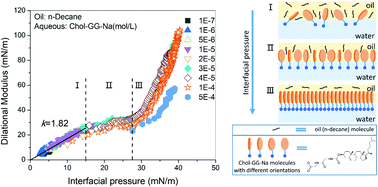Interfacial rheological behaviors of amphiphilic sodium cholesteryl glycylglycine
Abstract
The present study was conducted to investigate the effects of the strong van der Waals interaction and sterol skeleton of surfactants on their interfacial rheological behaviors by comparing the interfacial properties of sodium cholesteryl glycylglycine (Chol-GG-Na) and sodium lauryl glycylglycine (C12-GG-Na) at the oil–aqueous interface. The interfacial dilational rheological experiment results indicate a significant increase in the interfacial activity and intermolecular interaction with the introduction of the cholesteryl group. Therefore, a compact interfacial layer with a remarkably high dilational modulus was obtained with the adsorption of Chol-GG-Na. The cholesteryl group also has a significant impact on the dynamic processes such as it slows down the motion of the molecules due to which the diffusion exchange between the bulk and the interface decreases. Besides, the rigid skeleton makes rearrangement and conformation adjustment difficult. These impacts become more pronounced when the adsorption layer approaches a close and ordered arrangement, which has been confirmed by the relaxation measurements. The reported results provide a theoretical foundation for the potential applications of cholesteryl-based surfactants in the food, pharmaceutical, cosmetic and petroleum industries.



 Please wait while we load your content...
Please wait while we load your content...